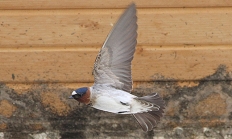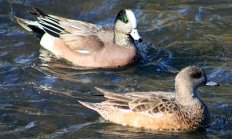Search myodfw.com
Known as "bluebill" to most hunters, this species is one of the most abundant and widespread of North American ducks. The lesser scaup is similar to the greater scaup in appearance and habits, but is smaller and lacks the white on the primaries. In the field, however, the black-and-white drakes and brown hens are very similar to greater scaups. The common vocalization is the purr call of the female; drakes are usually silent, but utter a low single-note whistle in courtship. In general, the lesser scaup is more apt to be found in interior or freshwater habitats while the greater

The smallest and hardiest of our resident bird species, Golden-crowned kinglets are remarkable for their ability to survive through severe northern winters when most other small insectivores have migrated to warmer climates. Spending winter nights in a squirrel's nest or huddled together in a sheltered spat are strategies this species uses for winter survival. Their high-pitched calls ring like tiny bells from the canopy as they flutter among the branch tips in small flocks, searching for insects wintering in conifer foliage and dead leaves. The Golden-crowned kinglet is very abundant year-round in coniferous forests from the Cascades and west throughout

Although they are one of the most abundant breeding birds in forests and woodlands west of the Cascade crest, it can be difficult to actually see Swainson's thrushes. Drab plumage and the habit of sitting very still hides them from the eyes of would-be predators and birdwatchers alike, especially in the shrubby habitats they favor. However, the beautiful song of this minstrel compensates for a lack of colorful plumage. During the longest days of summer, a chorus of liquid notes rising from the deep shadows each dawn and late afternoon reveals the actual abundance of this species in the conifer

Arguably the most widely recognized of Oregon's birds, the American robin is the largest, most abundant, and most widespread thrush in the state. Ranging from sea level to treeline, the robin's loud, musical voice and conspicuous brick-red chest make it unmistakable to even the most casual of observers. The robin thrives in both human-dominated and natural landscapes and is considered to be a habitat generalist throughout its range. Considering the robin's natural history, we know most about its diet, which comprises primarily of soft invertebrates in the spring and summer and fruit in the fall and winter. It is most

The House finch is the most widespread of Oregon's "red finches." It is a congenial, cheerful singer from urban areas to desert plateaus. The male has a red forehead, throat, eyebrow, rump and varying amounts of red in the breast. It may have small amounts of reddish wash in its otherwise brownish cheek, hindcrown, nape,and streaked back. In some males, red is replaced with red-orange, orange, yellow-orange or yellow. The female is drab grayish-brown, overall, with indistinct streaking above and no red. The House finch is a fairly common resident in lowlands, urban, rural, and agricultural areas throughout Oregon. They

Although a common breeding bird throughout Oregon's mountains, the Pine siskin retains an air of mystery due to its highly nomadic and unpredictable movements and its fondness for the inaccessible conifer canopy. It is most familiar in winter through early spring when flocks descend to foothills and valleys to feed on alder catkin seeds and many mingle with goldfinches in weed patches and at feeders. It is readily identified by its heavily streaked plumage and by the yellow wing and tail bars that are especially prominent in flight. The Pine siskin is a generally common resident in conifer forests throughout


The flight of Pacific loons by the thousands along the coast each spring and fall is one of Oregon's most dramatic bird migrations. Stunning plumage often clothes these fast-flying travelers. The straight bill, distinguishing Pacific from red-throated and yellow-billed, is less robust than that of common loons. The Pacific's head is larger and its neck thicker than those of the red-throated. In flight, Pacific's wing-beats are faster than those of common, loons the feet appear larger, the forecrown is rounder, and the hindcrown more sloped than those of red-throated loons. This is the most abundant loon off the Oregon coast

In Oregon, fork-tailed storm-petrels breed in numbers that are only a tiny fraction of those of Leach's storm petrels. This is the larger of the two storm-petrels breeding in Oregon and is gray in color. These birds leave and return to breeding colonies only at night, when they are best detected by their distinct raspy call. At sea, they are distinguished by quick, buoyant flight with short glides interspersed with wing fluttering to maintain their position at a food source. Fewer than 20 nests have been found in Oregon, all located in the same habitat as colonies of Leach's storm

Inconspicuous and master of stealth, the Least bittern inhabits densely vegetated deep-water marshes, making observations rare and difficult; its call is often the only way to detect this secretive species. The smallest of herons, its long neck and legs make it appear larger. The crown, back and tail of male birds is greenish black; purple-chestnut on female. Neck, flanks, and underparts are brown and white and the wings buff. It is a rare spring and summer resident in larger freshwater marshes of eastern Oregon and a very rare spring through fall visitor in the Rogue and Willamette valleys. At Upper

Cooper's hawks are smallish "bird hawks" (slightly smaller than American Crows) with rounded wings, a long rounded tail, and long yellow legs. This is the mid-sized accipiter nesting in Oregon and is larger than the Sharp-shinned hawk, but smaller than the Northern goshawk. The usual mode of flight consists of several rapid wing-beats alternating with brief periods of sailing. Juveniles are dark above with underparts streaked vertically while adults tend to have a bluish cast to their gray upperparts. The long tail is barred dark and light with narrow whitish band at the tip. It is an uncommon breeder in

This fragile-looking bird with bold black-and-white plumage and exaggerated, long, reddish legs is often associated with American avocets at shallow inland ponds and lakes. Very noisy and aggressive in protection of its nest and young, using a variety of distraction displays, including an impressive broken-leg act to lure away interlopers. The Black-necked stilt is a locally uncommon to fairly common summer resident of Klamath, Lake, Harney and Malheur counties. The largest Oregon breeding colony is at summer Lake. It has become a regular spring and fall migrant through eastern Oregon and irregular spring and casual fall migrant through western Oregon

The Least flycatcher closely resembles the Hammond's flycatcher, but its distinctive voice and choice of habitat help to identify calling birds. It was formerly an unexpected vagrant west of the Rocky Mountains, but since 1981 it has become recognized as a regular migrant and local summer resident in the state. It is found in deciduous groves along streams and in wet lowlands. It desires a deciduous overstory with at least some low brushy undergrowth. It is regular migrant and local summer resident in the state of Oregon with the spring migration from May to mid-June. The majority of sightings are

Dashing and darting about, flashing its bright white underparts, the Violet-green Swallow is one of the characteristic birds of summer. Unlike the Tree Swallow it commonly nests in niches and cavities on urban buildings and readily uses nesting boxes in residential areas. Its soft twittery call notes are a familiar pre-dawn sound as they fly about overhead. The Violet-green swallow is a very early spring migrant concentrating about streams and wetlands where emerging insects can be found until warmer weather allows them to move into more upland areas. It is a common to abundant summer resident and breeding species throughout

This chunky swallow is readily recognized by its square tail and orangish rump patch. It nests colonially and has taken to human-made structures so well that it has greatly expanded its range into many areas otherwise not suitable for it. It does not do well in urban settings, however, and quickly disappears when areas become densely settled. The unique gourd-shaped mud nest is often usurped by other species for nesting and is often used for protective roosting sites by rosy-finches and other wintering species. It is a locally common to abundant breeding bird near water throughout most of Oregon. Its

Wigeon drakes are beautifully marked with white pate, green eye stripe, purplish breast and flanks, white belly and wing covert patch, and iridescent black/green speculum. The grayish hen shows white on the wing covert patch. Drakes give a three-note whistle and get progressively noisier as spring approaches and courting flights begin. Medium sized flocks are common in fall and winter, and like geese, will be found grazing pastures, park lawns, and golf courses. It is a rare to locally common breeder in eastern Oregon and rare in summer in western Oregon. It is a common to abundant migrant and wintering

This moderately small wren maintains the frenetic energy that is so obviously typical of this family of birds. It is a summer inhabitant in many parts of Oregon, generally in open woodlands, thickets, and occasionally in residential gardens. The House wren occurs over the widest latitudinal range of any New World passerine. The House wren nests in a wide variety of native and human-influenced habitats. Nest sites are primarily located within preformed cavities in snags. It is a very uncommon to common transient and summer resident in semi-open woodland habitats throughout the state. In southwest Oregon, it is most common

The graceful short-distance flight of a bright male bluebird is a memorable sight. The Mountain bluebird haunts open country, providing an irreplaceable color note in the gray sagebrush landscape; particularly when in migration their brilliant blues flash in the desert sun in startling contrast to the prevailing dull colors of most other birds. Like other bluebirds, it readily accepts nest boxes. This accessibility, along with its sky-blue color, have always endeared it to nature lovers and made it a favorite of many. In Oregon, it is a common breeder and transient east of the Cascade summit except in treeless expanses

Shadow-colored skulkers in dense riparian growth, catbirds are among the often heard, less frequently seen denizens of northeast Oregon. They are all dark gray except for a black cap and russet undertail coverts. The sound has variable melodious warblings with occasional imitations of other birds and off-key noises. A distinct mewing call is often heard. The Gray catbird is a fairly common breeder in dense riparian zones of the northeast Blue Mountain ecoregion and is common in the Wallowa and Union counties and in east Umatilla County along the Umatilla River, Pine Creek and Meacham Creek. They breed locally in

This olive-green warbler is one of the drabbest of Oregon's Warblers., often showing obscure streaking on the underparts and indistinct dark eyeline. The species is named for its telltale orange crown spot but this feature is often hidden, reduced or absent in immature and female birds, and therefore rarely observed in the field. Orange-crowned warblers are one of the earliest and most abundant migrants in Oregon. They glean insects from the undersides of leaves and are often seen probing into dead leaf clusters and flower heads. Perhaps this is why they are able to winter farther north than most other

